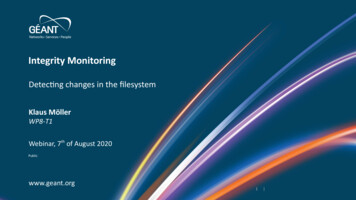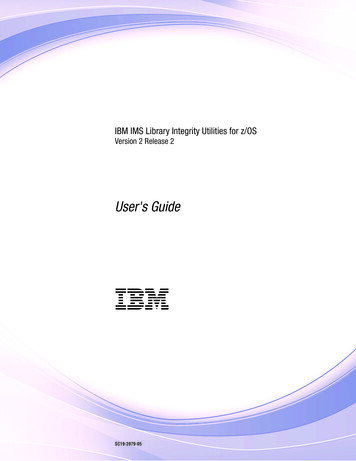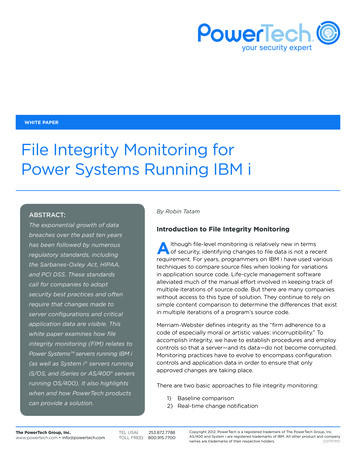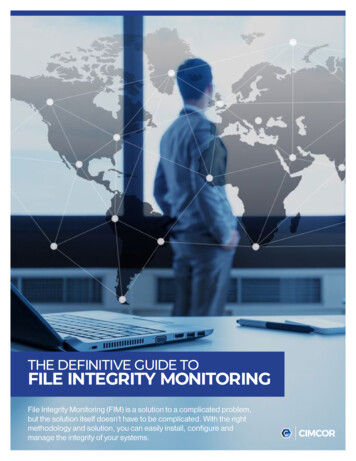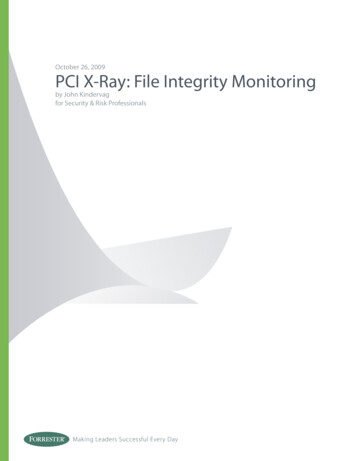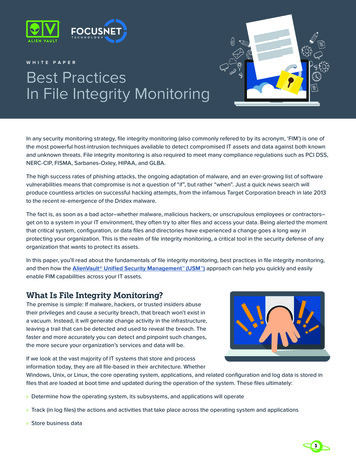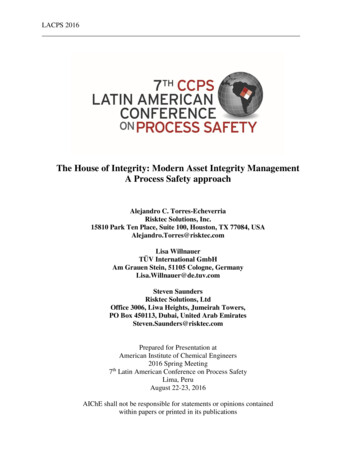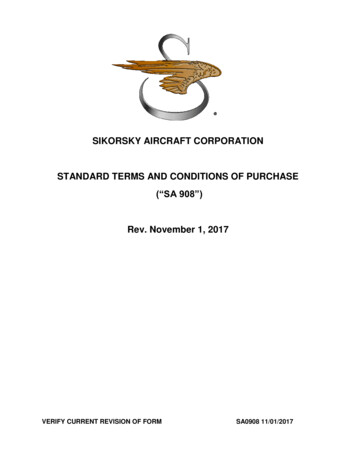
Transcription
FILE INTEGRITY MONITORINGBUYER’S GUIDECompliance and Security for Virtual and Physical EnvironmentsFOUNDATIONAL CONTROLS FORSECURITY, COMPLIANCE & IT OPERATIONS
Sections—Click to jump to pagePageWhat is File Integrity Monitoring?3What Gets Monitored?4A Checklist of Product Requirements5Operational Requirements6Security and Control Requirements7Enterprise Management Integration Requirements8Reporting and Alerting Requirements9Beyond FIM: Compliance Policy Management102
What is File Integrity Monitoring?In an IT network, a file can range from simple text file to a configuration script, andany change can compromise its integrity. A change to a single line item in a 100line script could prove detrimental to the entire file or even operating system. Forexample, incorrectly assigning the wrong IP address to a startup script or a newlyinstalled network printer could disrupt the network. Below are some examples ofthe type of configuration settings a file integrity monitoring solution detects andmonitors:Registry EntriesConfiguration files andparameters.exeFile and directory permissionsTablesIndexesStored proceduresFile integrity monitoring (FIM) solutions,also called change auditing solutions,ensure the file for a server, device,hypervisor, application, or other elementin the IT infrastructure remains in a knowngood state, even in the face of inevitablechanges to these files. Ideally a FIM notonly detects any changes to files, butalso includes capabilities that help ITimmediately remediate issues caused byimproper change. The following sectionsdescribe the capabilities often availablewith file integrity monitoring solutions.RulesAccess control lists stem filesWeb rootPorts and servicesProtocols in useESTABLISHES A BASELINEWhen IT deploys a system/componentinto its technology infrastructure, ittypically does so with the knowledgethat the component is initially configuredappropriately. A FIM solution captures theknown good state of the entire system’sIT configuration settings when it isdeployed—or when it has been configuredwith recommended settings—and usesthis state as a baseline configurationagainst which the solution can compare a later configuration. Many times thisconfiguration state is referred to as a golden, compliance, or configuration baseline.A baseline-to-current-configuration comparison lets the solution immediately andautomatically detect discrepancies caused by change.Given the rapid deployment of virtual machines, an ideal file integrity monitoringsolution would also include in the baseline the configurations of virtual environmentelements. These elements include the physical server, hypervisor, each guest OS,and all applications and databases running on a guest OS.ALERTS AND NOTIFIES I.T.When the solution detects change, IT needs to determine whether or not the integrityof a file has been compromised and whether the change requires immediateattention. IT should have the ability to specify which devices and files are critical—and therefore require high-level, immediate attention—versus those that do not. Forexample the configuration file of an e-commerce site or a database populated withsensitive customer financial or medical data would warrant immediate attention,while configuration changes to non-critical systems could be given a “best effort”response.Based on whether a system was viewed as critical or non-critical, the solutionshould be able to send alerts and notifications using a variety of methods to be sureIT receives them. For example, an email alert is worthless if the detected changedisrupted email service. Other methods of notifying IT include an alert in the systemtray, SNMP, CMD, SYSLOG, page, or within a management console. Early detectionenables the administrator to quickly make any necessary corrections beforedownstream effects become critical.Remote access3Return to Table of Contents
What Gets Monitored?File integrity monitoring solutions watch for changes to files associated with theservers, databases, routers, applications, and other devices and elements in theenterprise IT infrastructure. Files monitored may include registry files, configurationfiles, executables, file and directory permissions, tables, indexes, stored procedures,rules—the list goes on. In fact, the reality is today’s IT infrastructure is far toocomplex to be monitored manually, even in smaller organizations.This table provides a sampling ofthe type of IT configurations thesesolutions may monitor:File attributes being monitored mayinclude hostname, username, ticketnumber, date and time stamp andoperation type. This table provides anoverview of the type of attributes thesesolutions may monitor.Server sHypervisorsApplicationsWINDOWSUNIXAccess timeAccess timeCreation timeChange timeWrite timeModify timeSizeSizePackage dataPackage wnerGrowingGrowingMD5MD5SHA-1SHA-1Hidden flagStream countStream MD5Offline flagRegistry entriesTablesRouting tablesPrivileged groupPermissionsWeb server keysConfiguration filesIndexesFirewall rulesGroup policy optionsFirewall settingsSystem filesTemp flag.exeStored proceduresConfiguration filesRSoPAuditing/loggingLogsCompressed flagFile permissionsPermission grantsACLsAccess controlsRegistry settingsArchive flagSystem flag4Return to Table of Contents
A Checklist of ProductRequirementsWe’ve so far described what file integrity monitoring is and why it’sneeded. You’ve also learned what a FIM solution monitors and beloware some must-haves for the solution you choose: Analyzes and prioritizes each detected changeHelps reconcile authorized versus unauthorized changeHelps determine if a change took systems out of complianceProvides assistance in remediationINTEGRITY VERIFICATIONY/NCan automatically check for changes to file/directory contents.Can automatically check for changes to file/directory permissions.Can automatically check for changes to file/directory time/date stamps.Can automatically check for changes to file/directory names.Can automatically check for changes to file/directory ownership.Can automatically check for additions/modifications/deletions to Windowsregistry keys.Can check for file content changes using cyclic redundancy checking and/or digital signature checking.Following are detailed checklists for what you should look for whenevaluating any file integrity monitoring solution:Supports multiple hashing algorithms (e.g. MD5, SHA).INTEGRITY VERIFICATIONCan monitor security identifier and descriptor.The following requirements address how any file integritymonitoring solution should verify file and attribute integrity.Ability to correlate event audit logs to determine which user made a change.Can automatically detect changes to access control lists.Ability to detect changes to server file systems.Ability to detect changes to databases.Ability to detect changes to network devices.Ability to detect changes to directory services file systems.Ability to detect changes to hypervisor file systems.Ability to detect changes to virtual workloads.Ability to detect changes to virtual network devices (vSwitches).Ability to detect changes to application file systems.Ability to archive new versions of configurations as changes are detected and baseline configurations evolve.Examines parts of configuration file that apply to a compliance policy (internal and external) and comparesthe actual to the expected.Ability to reconcile detected changes with change tickets in a Change Management System (CMS) or a list ofapproved changes.Ability to analyze changes in real time to determine if they impact file integrity based on conditions underwhich change was made, type of change made and user-specified severity of a change.5Return to Table of Contents
Operational RequirementsThe following requirements address how any file integrity monitoring solution ismanaged and supported from a user perspective.OPERATIONAL REQUIREMENTSAbility to generate a baseline of a server(s) so that integrity is based on aknown good state.Ability to create a single baseline that can be distributed to a group of serversto verify differences from baseline (i.e. configuration verification).Execution of commands based on integrity violations.Policy files can be remotely distributed via a console to one or more machines.Y/NOPERATIONAL REQUIREMENTSAbility to automatically promote baseline.Ability to auto-promote changes when real-time analysis of change indicatesthey are inconsequential or beneficial.Management console that is cross platform (i.e. Windows and Unix).Management console can detect status of agents.Policy templates are available from vendor.Allows users to quickly compare two versions and quickly isolate changes ordifferences between versions.Files and directories can be grouped together in policy template (rule blocks).Agents operate on Windows , Linux and Unix.Specify severity level to individual files and/or directories.Can change agent passphrases from console.Supports file directory recursion.Transfer only delta change information for each scan (after the first), not allconfiguration data each timeConsole can view status of machines.Console can group agents.Scalability to address requirements of both individual departments and entireenterprise worldwide.Ability to have monitoring (view-only) only consoles available for defined users.Ability to provide users access from anywhere to a single location which allowsthem to view, search, and compare configurations.Templates can utilize wildcards or variables (to encompass minor differences infile system contents between systems).Provides immediate access to detailed change information.Can operate through firewall (ports opened).Arrange and manage monitored components in a number of ways including bylocation, device type, and responsibility.Works well in low bandwidth connections.Enables explanations, descriptions, or labels to be annotated to any version byusers.Can update snapshot database from console.Ability to easily and quickly update multiple baselines at once, in cases whereroutine maintenance and/or changes cause integrity violations.Y/NProvides authorized users the ability to establish one specific version as atrusted configuration for each system.Provides standard sets of defaults and templates for each operatingenvironment6Return to Table of Contents
Security and Control RequirementsThe following requirements address security requirements that any file integritymonitoring solution should include.SECURITY AND CONTROLY/NEstablish levels of access and control for specific groups of users.Assigns established access and control to particular groups of devices.Provides secure communication between devices and database.Increases ability to audit the network by placing relevant change information inone central repositoryInforms authorized persons of when, how and who made changes.Provides proof to management that various departments are in compliance withset security policies.Enables compliance with security and regulatory requirements (e.g. CIS, PCI, ISO,SOX, FISMA, FDCC, FFIEC, NERC, HIPAA, JSOX, GLBA, etc.)Reports devices that don’t meet established operational or regulatory policies.Analyzes changes in real time to determine if they introduce risk based on conditions under which change was made, type of change made and user-specifiedseverity of a change.Default policy templates to automatically check detected changes against internal or external policies.Console has auditing facilities.Communication link between agent and console is secure (SSL).Ability to verify agent security and pass phrases.7Return to Table of Contents
Enterprise Management Integration RequirementsThe following requirements address integration requirements that any file integritymonitoring solution should include.INTEGRATIONY/NCommand line interfaces and or API to allow for custom integration.Launch in context commands to provide the ability to launch and take actions fromother EMS systems.Interface launch commands (toolbar actions) to provide one click actions.Integration or links to change ticketing systems (e.g. HP OpenView, BMC Remedy,Peregrine, Tivoli) to correlate and match requested change tickets to actual changes.Integrates with security information and event management (SIEM) solutions toprovide log management capabilities and correlate change and compliance statusinformation with security event information from a single point of control.Ability to create tickets and/or incidents in change management system based uponintegrity violations.Integration into virtual management console to keep inventory information consistentand help secure virtual environments.8Return to Table of Contents
Reporting and Alerting RequirementsThe following requirements address reporting and alerting functionality that any fileintegrity monitoring solution should include.REPORTING AND ALERTINGProduct has multiple levels of reporting.Provides executive level summary reports/dashboards.Y/NREPORTING AND ALERTINGY/NAlerts users when configurations change and introduce risk or non-compliance, andprovides details on what change was made and who made the change.Reports can be sent via email.Alerts can be based on complex combinations of events using Boolean algebra (i.e.criteria sets)Reports can be sent as a SNMP trap.Provides a single source of change information.Reports can be sent to syslog.Specifies the relative significance of a change according to the monitoring rules for asystem component.Reports can be printed.Reports can be archived locally.Enables searches of configuration histories and audit logs for specified content usinga variety of search criteria and filters.Reports clearly denote severity levels of integrity violations.Allows searching to be predefined or saved for future use by all users.Reports can be filtered and searchable.Identifies all devices whose configurations differ from their designated baselines, oreither contain or are missing specified configuration settings.Reports can be exported to other applications (CSV, XML or HTML format).Audit logging that provides a change control record for all change activity by recording detected changes, added and deleted devices, modified user accounts, etc.Reports can be created on demand.Reports can easily be customized.Sends alerts to a Web Console, Network Consoles, email and pagers whenever ahigh-priority file, content or configuration change is detected.Console can send alert when agent connections are lost.Can differentiate authorized vs. unauthorized changes based on change window, whomade the change, what the change was, etc.Provides a role-based and customizable user interface.9Return to Table of Contents
Beyond FIM: Policy Compliance ManagementCompliance policy management ensures the integrity of your IT configurationsby proactively comparing them against internal policies or external policies forstandards, regulations and security best practices. By proactively identifyingmisconfiguration risks and providing prescriptive remediation guidance, policycompliance management enables a rapid return to a known and trusted state.COMPLIANCE POLICY MANAGEMENTWhen compliance policy management and file integrity monitoring capabilities arecombine, you gain complete configuration control and continuous compliance. You getthe initial confidence that systems are configured in a known and trusted state, andconfidence that by monitoring for and detecting any improper change they’ll maintainthat state.Vendor supplied policy templates.COMPLIANCE POLICY MANAGEMENT REQUIREMENTSSupports operational/performance policies out-of-the-box for business-critical applications.Superior file integrity monitoring—FIM that includes compliance policymanagement—requires not only the detection and reporting of unauthorized changes,specific types of changes, changes made under certain conditions and user-specifiedseverity of changes. It must also perform an assessment of how an existing—or justchanged—configuration compares with established organizational and regulatoryguidelines. Capabilities to look for are provided in this final checklist.Y/NAbility to compare an asset’s configuration state against a pre-defined policy to determinewhether or not the configuration is compliant.Seamlessly integrates with file integrity monitoring data to immediately reassess upondetected changes (continuous compliance).Supports Center for Internet Security (CIS) benchmarks out-of-the-box.Supports security standards (NIST, DISA, VMware, ISO 27001) out-of-the-box.Supports regulatory requirements (PCI, SOX, FISMA, FDCC, NERC, COBIT) out-of-the-box.Ability to easily modify standard policies to conform to unique organizational needs.Capture and automate own organizational (internal) policies.Ability to assess all the same platforms on which you are tracking changes, i.e. operatingsystems, network devices, data bases, directory servers, etc.Provides out-of-the-box remediation guidance to help fix non-compliant configurations.Ability to systematically waive policy tests to seamlessly integrate into complianceprocesses and requirements.Ability to detect and ignore files that are in a policy, but are not on the monitored system.Ability to run assess configurations against existing data without requiring a rescan.Ability to use same scan data in multiple, different policy checks without requiring a rescan.Provides proof to management that various departments are incompliance with set security policies.Ability to report “policy scorecards” to summarize the compliance status of a device.Ability to assign different weights to different tests that comprise a policy scorecard.Ability to ignore certain tests for certain periods of time (i.e. support for policy waivers).Ability to report on current policy waivers in effect and their expiration dates.10Return to Table of Contents
Tripwire is the trusted leader for establishing a strong cybersecurity foundation. Partnering with Fortune 500 enterprises, industrial organizations and government agencies, Tripwire protects the integrity of mission-critical systems spanning physical, virtual, cloud and DevOpsenvironments. Tripwire’s award-winning portfolio delivers top critical security controls, including asset discovery, secure configurationmanagement, vulnerability management and log management. As the pioneers of file integrity monitoring (FIM), Tripwire’s expertise is builton a 20 year history of innovation helping organizations discover, minimize and monitor their attack surfaces. Learn more at tripwire.comThe State of Security: News, trends and insights at tripwire.com/blogConnect with us on LinkedIn, Twitter and Facebook 2019 Tripwire, Inc. Tripwire, Log Center/LogCenter, IP360 and Tripwire Axon are trademarks or registered trademarks of Tripwire, Inc. All other product and company names are property of their respective owners.All rights reserved.BRFIMBG1j 1506
the type of configuration settings a file integrity monitoring solution detects and monitors: File integrity monitoring (FIM) solutions, also called change auditing solutions, ensure the file for a server, device, hypervisor, application, or other element in the IT infrastructure remains in a known good state, even in the face of inevitable
